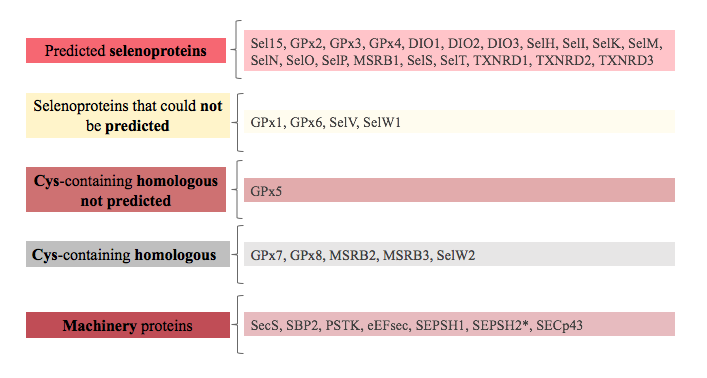Conclusions
The aim of this study is to identify and annotate all the selenoproteins and its corresponding machinery proteins in a specie that was not annotated, concretely in Manis javanica. Moreover, it also pretends to determine the grade of homology between human proteins related with selenium metabolism and Manis javanica ones. Apart from that, a personal objective is to learn how to manage html tools in order to create a web page and how to update results to an important database, SelenoDB.
In order to identify all the Manis javanica’s selenoproteins and machinery proteins there were two possibilities. On the one hand, to use an automatized program to obtain all the possible alignments. On the other hand, to analyze all the proteins by hand using bioinformatic tools. As a group we decided not to use a program. Mainly we thought that it will take too much time and we prefered to invest this time in analyzing each protein deeply. Then, all the human selenoproteins were blast against the Manis javanica’s genome in order to find the selenoproteins in this specie.
After the analysis of each human selenoprotein, the results obtained in Manis javanica are showed in the figure below:

All the 54 human proteins annotated in SelenoDB could be sequenced in Manis javanica resulting in 21 selenoproteins in Manis javanica against the 25 described in humans and 5 Cys-containing homologous in pangolin against the 6 described in humans (only GPx5 could not be predicted in Manis javanica). All the machinery is highly conserved in Manis javanica. According to the results obtained there are four selenoproteins in human that could not be described in Manis javanica: GPx1, GPx5, SelV and SelW1. These results suggest that it exists a good homology between human proteins and Manis javanica’s ones which is not surprising since they are really close species as both are placental mammals.
While the study was realized some limitations appeared. The most remarkable one concerned the GPx family and was pointed in the discussion. This family has a lot of intrafamilial similarities that lead to have the same scaffolds for each protein. The problem appeared when we had to choose the correct scaffold for each protein. This fact complicated the process because we obtained incomplete alignments and few and strange relations. Another problem appeared during the updating of the results into the SelenoDB database. Some proteins, concretely 7 are not updated yet because an unknown error blocked the updating. As a group, we are working in order to discover which is the problem and finish the updating. Taking into account the in silico programs used, Seblastian and SECISSearch, both are unspecific so many false positives had to be discarded and some selenoproteins were not found. The methodology used is a limitation for itself because it is a manual process so there are many points in which we could made an error that could alter the results. Another limitation is that there are few human proteins that are not well-annotated in the SelenoDB database such as XPO1 and others, that are too large so the analysis could not be done because neither genewise nor t-coffee worked. In XPO1, for example, we used another database, UniProt, to solve the problem. As a last limitation we would like to point out the fact that we could only obtain the selenoproteins in the university computers because we needed the Manis javanica’s genome, which we can only be found in these computers. This is a limitation due to the few disponibility of these computers.
In conclusion, the study performed represents a small contribution to the current selenoproteins’ knowledge by the description of the selenoproteome of Manis javanica, a placental mammal whose selenoproteins were not analysed until now.